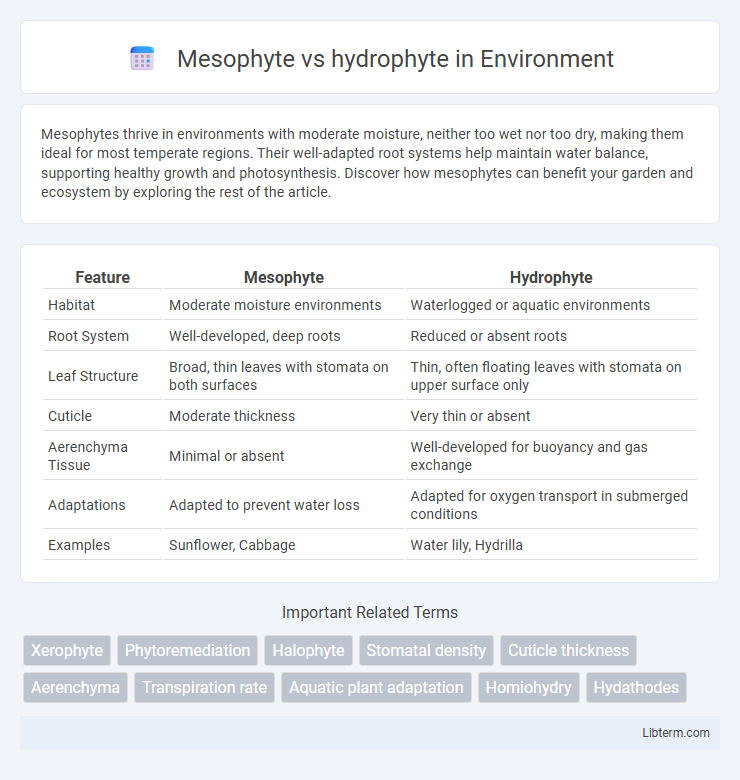Mesophytes thrive in environments with moderate moisture, neither too wet nor too dry, making them ideal for most temperate regions. Their well-adapted root systems help maintain water balance, supporting healthy growth and photosynthesis. Discover how mesophytes can benefit your garden and ecosystem by exploring the rest of the article.
Table of Comparison
| Feature | Mesophyte | Hydrophyte |
|---|---|---|
| Habitat | Moderate moisture environments | Waterlogged or aquatic environments |
| Root System | Well-developed, deep roots | Reduced or absent roots |
| Leaf Structure | Broad, thin leaves with stomata on both surfaces | Thin, often floating leaves with stomata on upper surface only |
| Cuticle | Moderate thickness | Very thin or absent |
| Aerenchyma Tissue | Minimal or absent | Well-developed for buoyancy and gas exchange |
| Adaptations | Adapted to prevent water loss | Adapted for oxygen transport in submerged conditions |
| Examples | Sunflower, Cabbage | Water lily, Hydrilla |
Introduction to Mesophytes and Hydrophytes
Mesophytes are plants adapted to moderate environmental conditions with balanced water availability, thriving in habitats such as grasslands and forests. Hydrophytes, on the other hand, are specialized aquatic plants that grow in water-saturated environments, exhibiting adaptations like air-filled tissues and reduced cuticles. These differences in water regulation and structural adaptations define their distinct ecological roles and distribution.
Defining Mesophytes: Characteristics and Adaptations
Mesophytes are plants adapted to environments with moderate water availability, exhibiting well-developed root systems and stomata that regulate gas exchange efficiently. Their leaves possess a balance between thickness and surface area, optimizing photosynthesis while minimizing water loss. Unlike hydrophytes, which thrive in aquatic habitats with specialized structures like aerenchyma for buoyancy, mesophytes rely on cuticles and stomatal control to maintain internal water balance.
Defining Hydrophytes: Characteristics and Adaptations
Hydrophytes are aquatic plants adapted to grow in water or very moist environments, displaying traits such as thin or no cuticle, large air spaces (aerenchyma) for buoyancy and oxygen transport, and specialized roots that may be reduced or absent. These plants have flexible stems and leaves to withstand water currents and often possess stomata on the upper leaf surfaces to facilitate gas exchange. Unlike mesophytes, which require moderate water conditions, hydrophytes thrive submerged or floating, showcasing unique physiological and structural adaptations for aquatic life.
Key Differences Between Mesophytes and Hydrophytes
Mesophytes are plants adapted to moderate environmental moisture conditions, featuring well-developed root and vascular systems for efficient water transportation, whereas hydrophytes thrive in aquatic or water-saturated environments with specialized adaptations like aerenchyma for buoyancy and gas exchange. Mesophytes typically have a thick cuticle and stomata on both leaf surfaces to regulate transpiration, whereas hydrophytes possess thin or absent cuticles and reduced stomatal density to accommodate their submerged habitats. Root structures in mesophytes are extensive for nutrient absorption from soil, while hydrophytes often have reduced roots since water and nutrients are directly available from their aquatic surroundings.
Environmental Requirements of Mesophytes
Mesophytes thrive in environments with moderate water availability, neither too dry nor overly saturated, typically found in well-drained soils with balanced moisture levels. These plants require adequate sunlight and nutrient-rich soil to support optimal growth, avoiding extremes such as drought or waterlogging. Their environmental needs contrast with hydrophytes, which are adapted to aquatic or waterlogged habitats with constant water presence.
Habitat Preferences of Hydrophytes
Hydrophytes thrive in aquatic environments such as freshwater lakes, ponds, marshes, and slow-moving rivers where water availability is constant and abundant. These plants exhibit specialized adaptations like aerenchyma for buoyancy and gas exchange, enabling them to survive in submerged or waterlogged conditions. Their habitat preferences contrast sharply with mesophytes, which require well-drained soils and moderate water supply.
Morphological Distinctions: Mesophytes vs Hydrophytes
Mesophytes exhibit well-developed root systems, thick cuticles, and moderate stomatal density to conserve water in environments with balanced moisture levels. Hydrophytes possess reduced or absent cuticles, large air-filled aerenchyma tissues for buoyancy, and extensive stomata primarily on the upper leaf surface to facilitate gas exchange in aquatic habitats. The morphological adaptations in hydrophytes, such as thin leaves and flexible stems, contrast sharply with the sturdier and thicker structures found in mesophytes, reflecting their respective adaptations to terrestrial and aquatic environments.
Physiological Adaptations in Mesophytes and Hydrophytes
Mesophytes exhibit physiological adaptations such as moderate stomatal density and well-developed root systems to optimize water uptake and prevent desiccation under varying moisture conditions. Hydrophytes possess specialized features like aerenchyma for enhanced gas exchange, reduced cuticle thickness, and stomata predominantly on upper leaf surfaces to facilitate oxygen diffusion and buoyancy in aquatic environments. These distinct adaptations enable mesophytes to thrive in balanced soil moisture, while hydrophytes are optimized for submerged or floating habitats with abundant water.
Ecological Roles and Examples of Mesophytes and Hydrophytes
Mesophytes, such as oak trees and dandelions, occupy environments with balanced moisture levels and play crucial roles in stabilizing terrestrial ecosystems by supporting diverse wildlife and preventing soil erosion. Hydrophytes, including water lilies and rice plants, thrive in aquatic or saturated habitats, facilitating oxygen diffusion in waterlogged soils and providing habitat for aquatic organisms. Both mesophytes and hydrophytes contribute significantly to ecological balance by supporting food webs and maintaining nutrient cycles in their respective environments.
Significance and Applications in Agriculture and Ecology
Mesophytes play a crucial role in agriculture by supporting crop varieties that thrive in moderate water conditions, optimizing water use efficiency and soil health. Hydrophytes contribute significantly to wetland ecosystems, aiding in water purification, preventing soil erosion, and providing habitat for aquatic life, which is vital for maintaining biodiversity. Understanding the distinctions between mesophytes and hydrophytes guides sustainable agricultural practices and ecological conservation efforts in diverse environmental conditions.
Mesophyte Infographic

 libterm.com
libterm.com